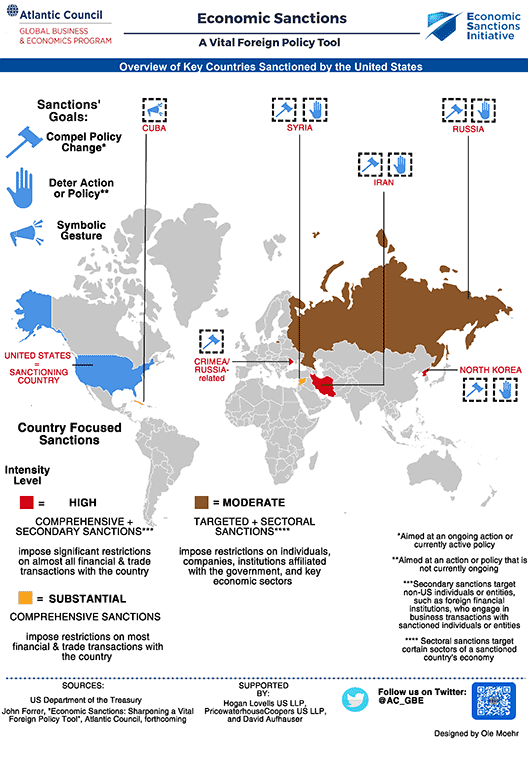This is the first EconoGraphic as part of our recently launched Economic Sanctions Initiative. The initiative aims to promote dialogue between the public and the private sector to investigate how to improve the design and implementation process of economic sanctions. The following text includes excerpts from our upcoming brief titled “Economic Sanctions: Sharpening a Vital Foreign Policy Tool” by our nonresident senior fellow John Forrer. Please visit our website to learn more about our work on economic sanctions.
Economic sanctions remain a popular foreign policy tool for several reasons. First, they can be designed and implemented quickly. Second, the initial consequences are immediate and tangible. Third, the rationale justifying their use as a response to unwanted international actions is easy to explain. Fourth, economic sanctions can be calibrated to respond to a relatively small or large international incident. Finally, sanctions provide for an invasive yet non-military foreign policy response.
In addition, and perhaps the most compelling reason for their appeal, sanctions can be designed and deployed to achieve many foreign policy goals. The most typical uses of economic sanctions to achieve these goals include:
1) Compelling another country to change unwanted policies by inflicting a level of economic suffering for a sufficient duration of time to make retaining the offending policy, including regime change, intolerable. An example is the sanctions against South Africa to protest its policy of apartheid.
2) Deterring another country from adopting an unwanted policy in the future by inflicting a level of economic suffering for action(s) already taken commensurate with the grievousness of the action. The economic sanctions against Russia for the annexation of Crimea fall into this category.
3) Making a symbolic gesture to diplomatically isolate the sanctioned country but with no expectations that the economic sanctions will impact the unwanted policies. The recent sanctions against Russia for its interference with the US electoral process is an example.
Of course, any given economic sanction may be adopted with the intent of achieving more than one of these goals. For example, the Russian annexation of Crimea provoked the US and European Union to impose economic sanctions. Some may view the sanctions as symbolic and therefore successful by having demonstrated a protest; others may view them as purposeful with the goal of compelling Russia to withdraw from Crimea and would therefore view the sanctions to-date as unsuccessful; and, others might view the sanctions as a deterrent to future similar ventures, their success to-date difficult to assess. To achieve their goals, economic sanctions utilize tools such as:
1) Restricting another country’s access to resources and financing that would be used to advance an unwanted policy or practice. A prominent example is the economic sanctions employed against Iran’s nuclear weapons development program.
2) Restricting another country’s access to financial assets that could otherwise be used as reparations for actions of the sanctioned countries. The economic sanctions against Iran that froze Iranian assets housed in the United States is one example of this practice.

Yet, despite economic sanctions’ popularity as a foreign policy tool, their ability to deliver sustained impacts on target countries, persons, or entities is hotly contested. The issues that have been raised to question whether economic sanctions “really work” are even more relevant today. A rapidly transforming global economy puts markets, trade, and investments in a continual state of adjustment and change. That means assessments of countries’ vulnerability to economic sanctions must be updated regularly, taking account of their interconnectedness within the global economy as the economy changes over time. To be effective, it is critical that the design, implementation, and measurement of economic sanctions’ impacts be properly calibrated to the economic realities of the moment and anticipate the future, not the past.